As pretty much every NHL fan knows, the Nashville Predators were eliminated from the 2019 Playoffs. They fell to the Dallas Stars in overtime in Game 6 after never gaining a stronghold on the series. As the Central Division winners, the Predators were technically the favorites, but the series was viewed as a toss-up at best. That last sentence was the theme for the Predators in 2018-19: should have been the favorites, but failed to live up to expectations.
Although this early exit is a difficult pill to swallow, it isn’t surprising. Since reaching the 2017 Stanley Cup Final, they’ve been eliminated in an earlier round each of the past two seasons. Going back to before the 2014-15 season, there’s a clear line of moves that leads to the present, a team seeking answers after another season of failed expectations. Sure there was the climb that peaked with a Western Conference championship, but since then it’s all been downhill, and the decisions that helped in the climb were also part of the regression.
2014-15: Laviolette’s First Season
Following the 2013-14 season, the Predators had had exactly one head coach (Barry Trotz) and one general manager (David Poile) in franchise history. They were coming off a season in which they had missed the playoffs for the second straight season after reaching them three straight seasons between 2009-10 and 2011-12. They had never advanced beyond the conference semifinals.
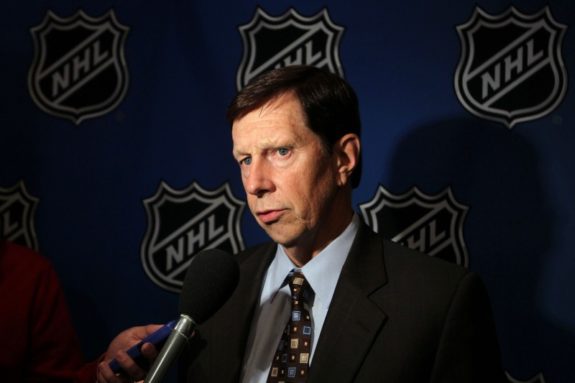
Soon after the 2013-14 season concluded, Poile announced that Trotz had been let go. In his place, the Predators hired Peter Laviolette, former head coach of the New York Islanders, Carolina Hurricanes and Philadelphia Flyers. He brought with him a winning pedigree that included a Stanley Cup win in 2006 with Carolina and a Cup Final appearance in 2010 with Philadelphia. Also during the offseason of 2014, the Predators signed Mike Ribeiro to center their top line, giving the Predators a decent one-two punch down the middle with Mike Fisher. That summer they also acquired James Neal from the Pittsburgh Penguins to add a reliable goalscorer.
Related: Laviolette Wins 600th NHL Game
The moves the team made worked, finishing second in the division with 104 points. They were led offensively by a 20-year-old Filip Forsberg’s 26 goals and 63 points. It was also the rookie seasons for Viktor Arvidsson, Kevin Fiala and Miikka Salomäki. The Predators were ousted in six games by the Chicago Blackhawks in the first round.
2015-16: Trading for Johansen
The offseason following the 2014-15 season was a quiet one for the Predators. The only free agents they signed were Barrett Jackman and Cody Hodgson, and neither made a lasting impact. The team did buy out the contracts of Rich Clune and Viktor Stalberg, the latter whose buyout lasted through the 2018-19 season. The Predators had a strong regular season, with 96 points and a fourth-place finish in the division.
Their season was made better with the January acquisition of Ryan Johansen from the Columbus Blue Jackets. This trade addressed the team’s perpetual need for a first-line center. They paid a large price by giving up young defenseman Seth Jones, but it was a good one-for-one hockey trade in which both teams were bettered. Although skeptics questioned whether Johansen was a 1C, he’s proven them wrong as he’s developed into one of the game’s better playmaking centers and is the driving force of the team’s top line.
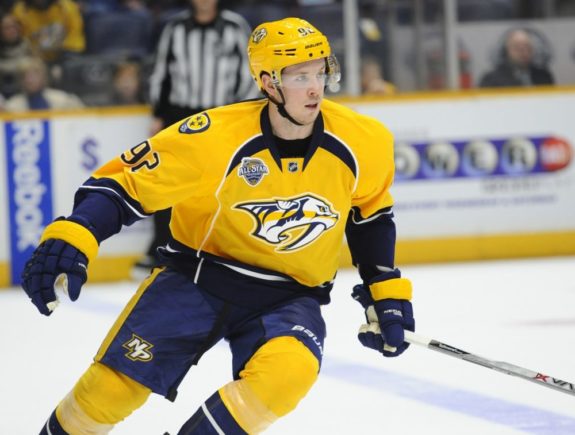
Once again Forsberg led the team in scoring with 33 goals and 64 points. In the postseason, the Predators defeated the Anaheim Ducks in the first round with the series going the full seven games and setting up a rivalry in the process. They faced the San Jose Sharks in Round 2. That series also went seven games, this time resulting in a Predators loss. They didn’t reach their ultimate goal, but made strides by winning a round. They also landed their top center and the team’s current roster was taking shape with Juuse Saros making his NHL debut.
2016-17: Stanley Cup Final
Fresh off advancing a round, the Predators went into the summer looking to upgrade their roster. They started by drafting Dante Fabbro, Samuel Girard and Rem Pitlick in the draft, all three players who would have an impact on the team in coming seasons. They followed that up by pulling off one of the bigger one-for-one trades in recent memory when they sent captain Shea Weber to the Montreal Canadiens for P.K. Subban.
That move sent shockwaves throughout the league and it was analyzed from all angles. The consensus appeared to be that the trade could be a wash in the early seasons, but it would be a Predators win long-term. The team later added defensemen Matt Irwin and Yannick Weber in free agency.
Interestingly, despite these additions, the Predators finished the regular season in fourth place with 94 points. It was the second straight season of regular-season regression. For the first time since 2013-14, someone other than Forsberg led the team in points with Arvidsson and Johansen both posting 61 points. Forsberg still had a great season, however, with 58 points. The 2016-17 season was that trio’s first as the JOFA Line and they drove the team’s offense.
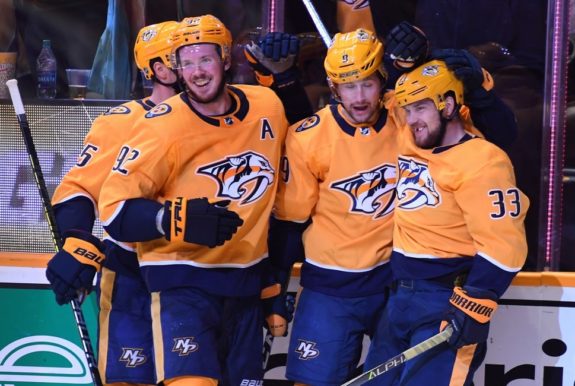
Although they were the eighth seed in the Western Conference and the league’s 16th seed, the Predators upset the top-seeded Blackhawks by sweeping them. They followed that up with a six-game series victory over the St. Louis Blues in the second round and a hard-fought win over the Ducks in the conference finals, also in six games. They faced the Penguins in the Stanley Cup Final, their first in franchise history, and lost the series in six games.
During the postseason, the Predators’ speed and quick transition style gave teams fits. They were seemingly able to send wave after wave of offense at the opposition with little dropoff down the lines. It also helped that they had an active defense that was unafraid to play deep in the offensive zone.
They played so well in the playoffs that had Johansen not gotten hurt (13 points in 14 games) and missed the Cup Final and had Neal not broken his hand, the Predators likely would have won the Stanley Cup. It also didn’t help that Pekka Rinne was pulled in two of six games versus the Penguins. The Predators dominated five-on-five play and their style was problematic for the Penguins, but the lack of a number one center, plus the absence of center depth behind Johansen, cost the team the series.
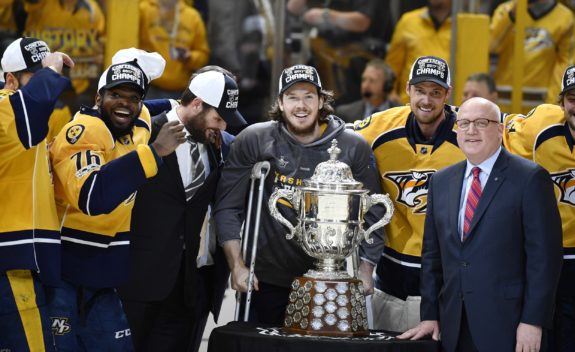
2017-18: Presidents’ Trophy Leads to Second-Round Exit
Anytime a team reaches the Stanley Cup Final and has a relatively young core like the Predators did in 2016-17, expectations have to be sky-high the following season. Poile and the front office entered the 2017 offseason with the goal of strengthening the team. After losing Neal to the Vegas Golden Knights in the Expansion Draft, Poile selected Eeli Tolvanen in the entry draft after he fell to 30th.
The team then added center depth with Nick Bonino and signed veteran Scott Hartnell in free agency. Poile further dealt Colin Wilson to the Colorado Avalanche and acquired Alexei Emelin from the Golden Knights. He also re-signed Arvidsson, Johansen and Austin Watson. However, the summer was not all positives, as captain Mike Fisher announced his retirement in August, once again creating a hole at center.
The team entered the season with Bonino, Calle Järnkrok and Colton Sissons splitting second-line center duty. They started off playing mediocre, with a 7-5-2 record through 14 games. A big reason for this was a lack of center depth. Poile attempted to remedy this by acquiring Kyle Turris from the Ottawa Senators on Nov. 5 to be their second-line center. Turris got off to a great start with 17 points in his first 17 games.
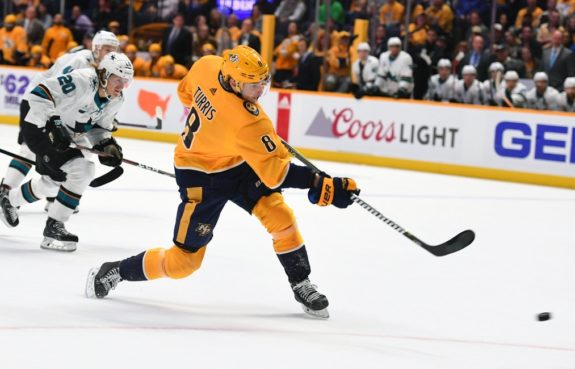
However, afterwards he only had 25 points in his final 48 games. Despite Turris’ lackluster finish to the season, Ryan Ellis being held to 44 games, Forsberg missing 15 games and the team having an abysmal third defense pair, the Predators posted a franchise-record 117 points and won the franchise’s first Presidents’ Trophy and division title.
Related: Kyle Turris Trade a Year Later
They overcame injuries thanks to Rinne’s dominance that resulted in a Vezina Trophy as well as great seasons from Subban and Roman Josi. The JOFA Line once again drove the team offensively with Forsberg’s 64 points leading the way.
They entered the postseason as the league’s best regular-season team and drew the Avalanche in Round 1. What was expected to be an easy series ended up being a six-game struggle from which they emerged victorious. That paved the way for a conference semifinals showdown with the Winnipeg Jets. The series went seven games, with the Jets winning, but the Predators eked out two of their three wins and never looked like the better team. The team’s postseason struggles were fairly obvious: Rinne had a .904 save percentage (SV%), a 3.07 goals-against average (GAA) and was pulled in four games. Meanwhile, Saros had a .952 SV% and 1.06 GAA in four appearances, all in relief. The problem was that Laviolette never put Saros in with enough time remaining to salvage the game. A sign of things to come?
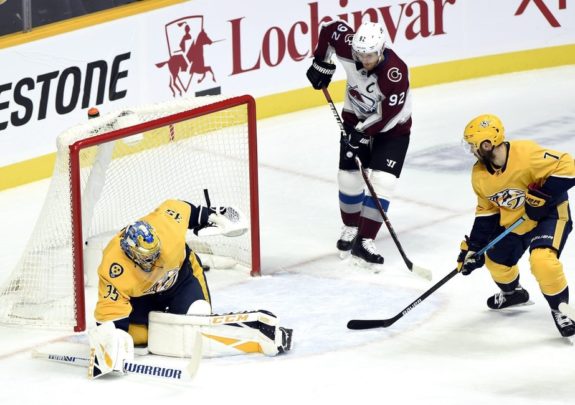
The other big issue was the continual lack of scoring from the second line. The JOFA Line combined for 39 points in 13 games while the rest of the forwards combined for 36 points. Yikes! That included Turris totaling three points in 13 games as the team once again didn’t have center depth. Oh, and the Ellis/Josi pair was terrible with only nine points and a minus-eight rating between them. In the first round, the Predators struggled with the Avalanche’s speed, and in the second round, they couldn’t match the Jets’ physicality. Both were, again, a sign of things to come.
2018-19: Losing Predictably in the First Round
Fresh off a Presidents’ Trophy and early playoff exit, Poile kept the roster relatively intact. He added veteran defenseman Dan Hamhuis and speedy winger Rocco Grimaldi in free agency. He also re-signed Salomäki and Saros and extended Ellis. Having reached the playoffs four seasons in a row and with an experienced roster, the Predators were again expected to be one of the league’s serious Stanley Cup contenders.
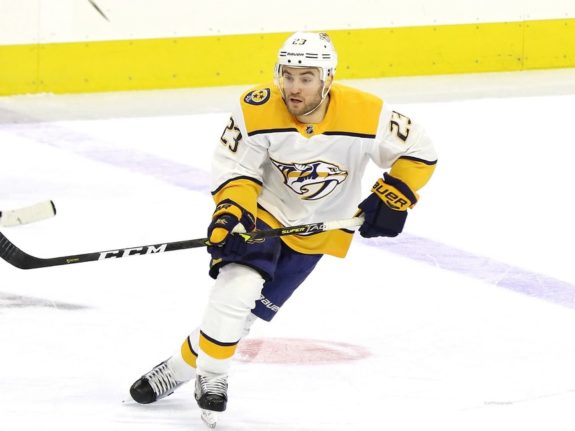
They started the season on fire with a 13-3-0 record through 16 games. However, injuries to Arvidsson, Forsberg, Hamhuis and Subban negatively impacted the team’s play. Despite these key injuries, the team stayed afloat and was still in contention for a division title when those four returned to the lineup. With no other team taking control of the division, Poile was a buyer at the trade deadline, adding Brian Boyle, Mikael Granlund and Wayne Simmonds. On the surface, all seemed like great moves, yet only Boyle consistently produced and the team continued to lack second-line scoring.
Coupled with average goaltending from Rinne and Saros, the Predators won the division by one point. The JOFA Line, unsurprisingly, guided the team with Johansen leading the team with 64 points. Arvidsson even set a franchise record with 34 goals, doing so in 58 games. However, no other forward had more than 38 points, with Turris only posting 23 in 55 games and was even a healthy scratch two times down the stretch.
The Predators drew the Stars in the first round and it was tough to be confident entering the postseason. That lack of confidence proved correct as they were ousted in six games. This time the JOFA Line didn’t carry the workload with only four points. Grimaldi was the team’s only forward with multiple goals (three) and Josi led the team with four points. Other players like Granlund, and even Turris, looked good but were unable to produce. Rinne had another terrible postseason with a .905 SV% and a 3.09 GAA, while Saros had a .952 SV% and a 1.32 GAA. Rinne was pulled in one game, but the decision was again made too late to affect the outcome. He also should have been pulled in at least one other game.
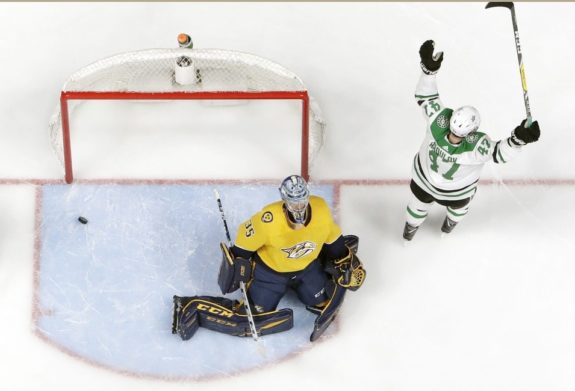
The series loss itself wasn’t a big deal, the Stars played great hockey. It was the manner in which the Predators lost that is such a letdown. The team’s vaunted top-four struggled, especially Ellis and Mattias Ekholm, the team still can’t find a second scoring line, the JOFA Line was held in-check and Rinne again regressed into a shell of his regular-season self. What was unexpected was the lackluster coaching that manifested in keeping Rinne in net too long, not changing lines until Game 6, an unwillingness to alter the team’s zone entry or breakout and doing nothing to help the team’s pathetic power play that went 0-for-15 in the series.
Personnel-wise, the team couldn’t compete with Dallas’ physicality and speed. They also had no forwards who could consistently enter the offensive zone with possession. Additionally, the lack of a pure sniper made their power play a joke. All were serious issues that were preventable and it sets the team up for a summer in which major questions need asked, and hopefully answered.
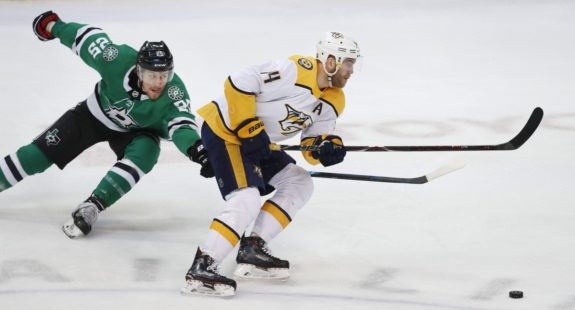
This roster structure was birthed before the 2014-15 season, and while it looked great at the start, it’s been a source of struggle in recent seasons: the small, speedy forwards that represent the majority of the lineup are great but lack the physical edge needed in the playoffs; an elite top-four defense is wonderful but is easier to shut down than an elite top-six forward group; and they still don’t have a second line that can take the pressure off the JOFA Line.
A Summer Filled with Questions
Below is a list of questions I feel need to be asked (and hopefully answered) before the 2019-20 season begins:
- Can the Predators win with current core?
- Does the top-four need dismantled with Fabbro’s emergence? And, if so, who goes, and for what?
- What do they do with Turris?
- Is adding a second-line center enough?
- Do they move Tolvanen?
- Is Laviolette the right coach?
- How do they fix power play?
All of these questions I plan on answering in the coming weeks. This team has the framework of a winning club, but needs help. The fact that you can track the current struggles back five seasons is alarming. Hopefully with the right fixes this summer, the struggles can be reversed and the team can get back on track.
*All stats from Hockey-Reference